#175 bce
Text
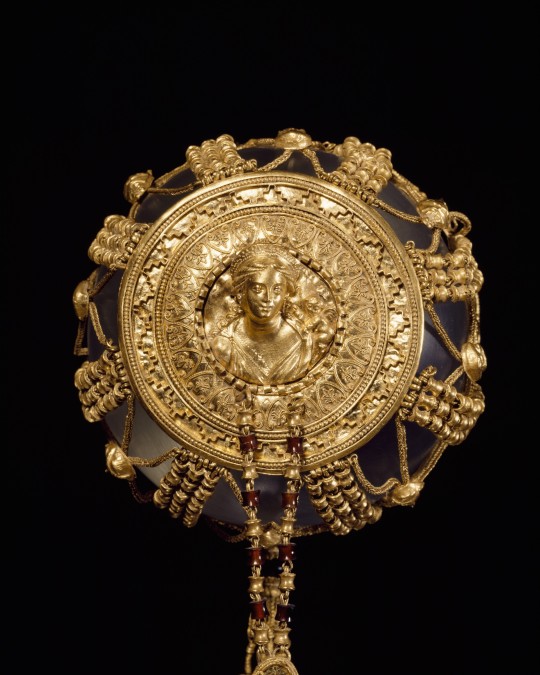
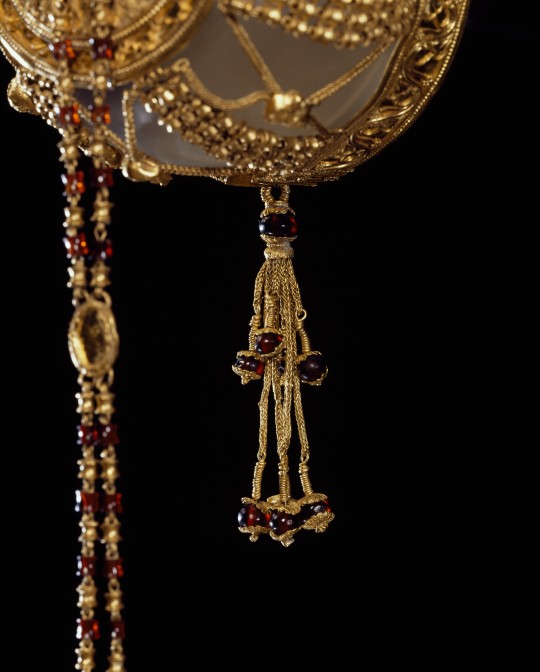

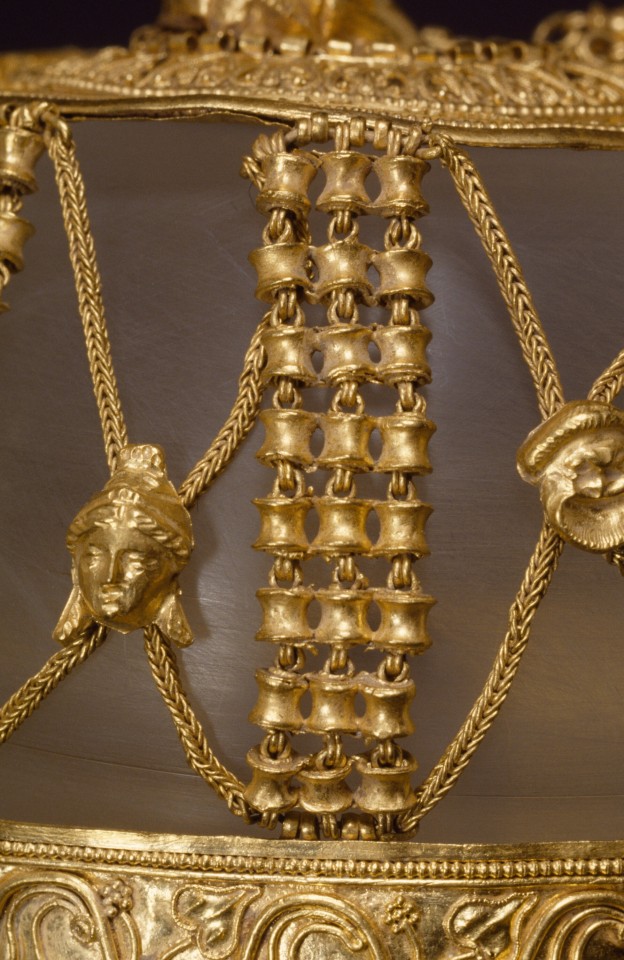
Gold hairnet, Ptolemaic, 225-175 BCE
From the Getty Villa Museum
#hairnet#gold#fashion#fashion history#accessory#history#225 bce#200s bce#175 bce#100s bce#bce#ancient#ptolemaic#ancient greek#ancient egyptian#greek#egyptian#ancient greece#ancient egypt
651 notes
·
View notes
Photo

Manticore
The Manticore, derived from the Early Middle Persian merthykhuwar or martiora, meaning "man-eater" (also known as a mantichora or a martichore), is a fearsome hybrid creature found in classical and medieval literature. It has the body of a lion, the head of a man and a scorpion tail that can shoot poisonous darts.
The manticore is one of the most bizarre and ferocious creatures depicted throughout classical and medieval bestiaries. Its roots can be traced back to India and Persia (modern-day Iran). The myth of the manticore spreads over several centuries and is mentioned most famously by Ctesias (5th century BCE), Pliny the Elder (23-79 CE) and Pausanias (c. 115 to c. 180 CE).
Appearance & Characteristics
The earliest known mention of the manticore comes from the Greek historian and physician Ctesias in his Indica (written in the 5th century BCE). Although the Indica is now lost to time, fragments of Ctesias' work exist in other authors' writings, and we have a clear description of the manticore. According to Pliny the Elder in his Natural History:
Ctesias writes that amongst these same men there is found an animal called the Mantichora which has three rows of teeth like a comb, the face and ears of a human, and bluish eyes. It is red in colour with the body of a lion and a tail with stingers like a scorpion. Its voice is as if the sounds of the pipe were mixed with a trumpet and it is a creature of great speed which avidly goes after human flesh. (8.75)
Pliny's account of the manticore influenced later writers. He seemed to give the monster a basis in reality as he was considered the expert on strange and marvellous creatures for hundreds of years.
The morphology of the manticore was believed to have developed from its environment – the rugged and barren landscape of the Indian and Middle Eastern deserts. It needed to be fierce and to have weapons at its disposal to be able to catch its prey and prevent being caught by predators. Initially preying on animals like pigs and mountain goats, the manticore began to be lured to villages by the livestock it was hunting and inevitably began to attack and feed on humans, establishing the lore of the man-eating manticore.
The manticore would famously leave no trace of its prey behind. It could attack a human up close with its sharp claws or shoot poisonous darts from its scorpion tail from a safe distance. When it unleashes the poisonous darts from its tail, the tail either bends back or stretches out. Roman writer Aelian (175-235 CE) states that "whatever it hits, it kills, with the exception of elephants" (Characteristics of Animals, 4.21). The poisonous stingers are described as being thick as a rope and one foot (30 cm) in length. Once a stinger has been discharged, another one grows in its place.
Manticores did not just satisfy their appetites by killing one human but would chase after multiple people at a time, taking great pleasure in the hunt. Its favourite way to lure and hunt prey was to hide its body in the long grass, so from a distance, all humans would be able to see would be a human head. Deceived by this, humans would get close to the manticore, and before they knew what was happening, they would be attacked and killed. This showed how cunning and clever the manticore was. Although humans were undoubtedly a manticore's preferred prey, they would also regularly hunt the animal kingdom, except for lions which they could never overpower.
In order to stop the manticores' aggressive nature, the Indians would hunt baby manticores and smash their tails with rocks to prevent them from growing and shooting their poisonous darts and thus taking away their ability to harm humans from a great distance. Manticores lived in burrows deep under the ground where they could hide from their prey and avoid being seen by humans.
Continue reading...
91 notes
·
View notes
Text






Ancient Equestrian Statues
Marcus Nonius Balbus, 1st century BCE (MANN,July 2019)
2. Funerary statue of a child. Via Ostiense, Rome, 3rd century CE. (Baths of Diocletian Museum, Rome, July 2015)
3. Jockey of Artemision, 150-140 BCE. ( National Achaeological Museum of Athens, October 2008)
4. Dioscuri statues, from Theatre of Pempey (Piazza del Campidoglio, July 2012)
5. Marcus Aurelius, c. 175 CE (Capitoline Museums, July 2007)
6. Statue of a youth on horseback (British Museum, July 2022)
#equestrian statue#ancient Rome#ancient Greece#ancient#art#Roman#Greek#marble#bronze#horse#animal#statue#Equestrian#my photo
98 notes
·
View notes
Text

After we light the candles on Hanukkah there is a tradition that women refrain from work while the candles are burning. Why are women given this special honor? Because of Judith, the Jewish woman who singlehandedly saved her entire town during a brutal siege.
At the time of the Maccabee revolt, around 175 BCE, the Greek Empire ruled Judea. The Jewish town of Bethulia was under siege by Holofernes, a brutal general. He demanded that the Jews stop practicing their religion and instead adopt Hellenistic values and culture.
The Jews refused to bow to the Greek gods. Holofernes tried to starve them into surrender, cutting off the food and water supply to Bethulia. The townspeople grew desperate. They begged their leaders to surrender. Uzzia, the commander of defense forces, refused, but finally agreed to wait five more days, and if no salvation came, he would surrender.
At this point Judith (Yehudit), daughter of the high priest, stepped forward in outrage. “Why do you test G-d, giving Him only five days in which to send us His help? If you truly have faith in G-d, you must never give up your trust in Him. Don’t you know that surrender to Holofernes is worse than death??”
Judith came up with a plan. A beautiful young widow, she dressed in her nicest clothes and traveled to the enemy camp, praying as she went. She carried a basket with wine and salty cheese. Judith told the sentries at the gate that she had information for Holofernes regarding how to finally take the city of Bethulia. Dazzled by her feminine charm, they let her in to see the general.
Judith went into Holofernes’ chamber. The general was pleased to see such a lovely young woman, and accepted her wine and cheese. The cheese was so salty that it made him drink a great deal of wine, and soon he fell asleep. Then Judith unsheathed Holofernes’ sword, and chopped off his head.
Humiliated at their defeat by a woman, the Greek forces retreated from Bethulia, allowing the Jews to live freely and practice their religion.
For her stunning courage in slaying the enemy of her people, we honor Judith as our Thursday Hero, Hanukkah edition.
Accidental Talmudist
338 notes
·
View notes
Text

WINGED VICTORY OF SAMOTHRACE (NIKE OF SAMOTHRACE) b. 200-175 BCE
This is a masterpiece of GREEK sculpture from the HELLENISTIC era. It is a colossal statue representing the goddess NIKE (VICTORY), composed of a white marble statue and a grey marble ship's bow base
The sculpture depicts NIKE alighting on the ship's bow, with her wings dramatically outstretched behind her and her drapery billowing in the wind. This dynamic composition conveys a vivid sense of movement and energy, as if the goddess has just descended from the heavens to announce a naval victory.
The sculptor's technical mastery is evident in the construction of NIKE'S wings, which were carved from marble and inserted into slots on her back. This innovative approach allowed the creation of large, unsupported wings without the need for external support, a rare feat in ancient GREEK sculpture.
Stylistically, the NIKE of SAMOTHRACE exemplifies the HELLENISTIC aesthetic, with its dramatic, emotive pose and the eroticized rendering of NIKE'S body beneath the sheer drapery. The statue was intended to be viewed from multiple angles, encouraging the viewer to physically engage with the artwork
Regardless of the specific historical context, THE WINGED VICTORY OF SAMOTHRACE stands as a masterpiece of HELLENISTIC sculpture, celebrated for its technical virtuosity, dynamic composition, and emotive power.
#the winged victory of samothrace#hellenistic#hellenism#hellenic deities#Hellenistic sculptures#greek mythology#greek tumblr#greek gods#greek posts
38 notes
·
View notes
Text
Body Fat in Greco-Roman Antiquity (transcribed article)
A long time ago I made a post about the depictions of Dionysos/Dionysus/Bacchus as fat. You can read it here if you want - but that was just me going on about stuff taken left and right, nothing too serious, just thoughts.
I want to bring you today a serious article about the perception of the fat body in Ancient Greece and Ancient Rome. This article is actually a page hosted on "Google Arts and Culture", titled "In the Flesh: Body Fat in Ancient Art". It was created by the J. Paul Getty Museum, and you can read it all here. But the website has a really specific design that makes it hard for some people to read the page, so I thought why not help share it around by copying it below. Of course, nothing belongs to me, I am just transcribing it all (plus copying the images). All credits go to the J. Paul Getty Museum.
In the Flesh: Body Fat in Ancient Art
Ancient Greek and Roman writers criticized bodies of different sizes for a variety of reasons. But in works of art, body fat was often depicted in ways that defy our expectations.
A Different Ideal
Terms like "overweight" and "underweight" originate in modern medicine's concept of an ideal body weight. Calculated to minimize mortality risk, this medically desirable weight varies based on such factors as height, age, and fitness.
Ancient Greeks and Romans compared the appearance of their bodies with respect to a more abstract ideal.
For the ancient physician Galen, measurements for the ideal body were expressed centuries earlier in the Canon, a treatise on statue proportions by the 5th-century BC sculptor Polykleitos:
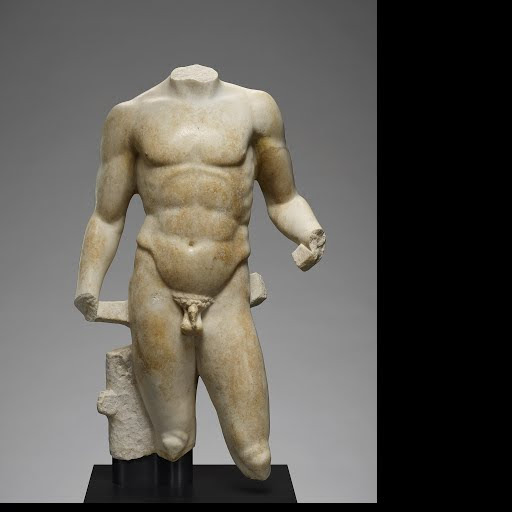
(Male torso, about A.D. 100, Unknown)
"[Neither the overweight nor the underweight body] is in due proportion. But the body which equals the Canon of Polykleitos reaches the summit of complete symmetry."
— Galen, Ars Medica K 343
For the ancient Greeks, precisely measured weight was less important than the perception of symmetry and balance.
They had a term for this desirable state of wellness: εὔσαρκος (eusarkos), meaning "well-fleshed" or "fleshy."
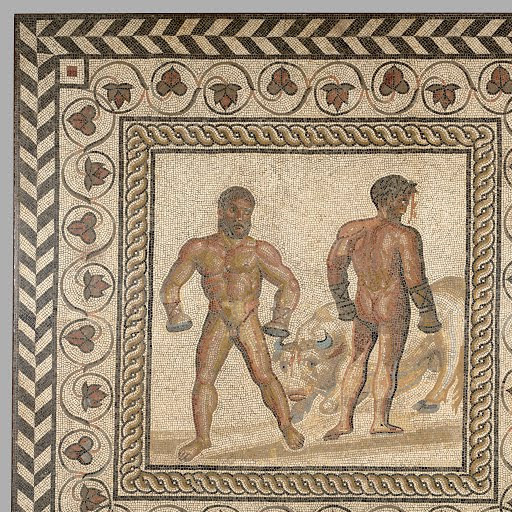
(Mosaic floor with combat between Dares and Entellus, A.D. 175-200, Unknown)
Because the Greeks prized moderation in all things, bodies or behaviors that stood out from this ideal were targets of criticism. Perhaps surprisingly, this criticism also applied to muscular athletes, such as wrestlers and boxers, who required constant high-calorie diets.
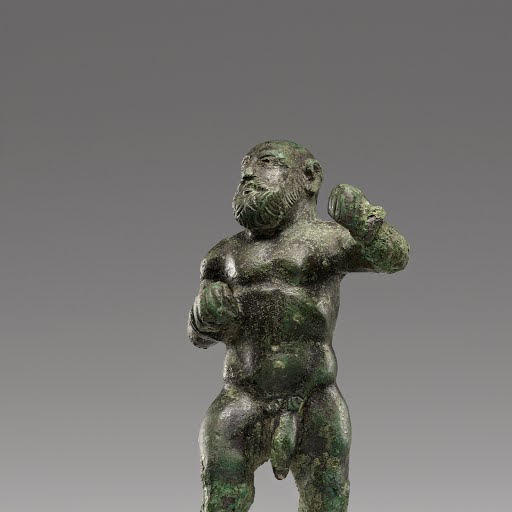
(Statuette of a boxer, unknown)
Big Bodies in Comedy
Mockery of those who ate more or less than necessary was one way to impose social compliance and maintain political order.

(Apulian red-figure bell krater, 370-360 BCE, Cotugno painter)
Many Greek and South Italian vases often depict comic actors wearing "fat suits" (as well as a mask and a phallus) to embody popular character types.
Actors used such props as comic gags, and vase painters often represented them with great care.

On this Apulian mixing bowl, lines extending across the actor's chest make clear that his large, sagging breasts are artificial. His belly is unnaturally circular and hangs too low — further evidence that he is wearing a costume.
It seems that the painter wanted to pointedly emphasize the exaggerated nature of such costumes.
Ample Satyrs
Not all depictions of larger bodies were mocking. Animal ears and the double flute identify this figure as a satyr, or a woodland deity. He reclines in a pose that would remind viewers of the satyrs' master, the wine god Dionsyos, who is often depicted reclining at a banquet.
Instead of on a fancy couch, the chubby old satyr rests on a full wineskin!

(Fragment of an Apulian squat Lekythos, 350-325 BC, Darius painter)
Under tufts of gray hair, lines accentuate the curving folds of the old satyr's body. Unlike the ridiculously artificial bodies of the padded actors, the satyr's big, hairy body is gentle and soft.
Like the plump pillow on which he rests, the satyr appears comfortable and at ease. This scene is meant to be lighthearted, and does not appear cruel or mocking.
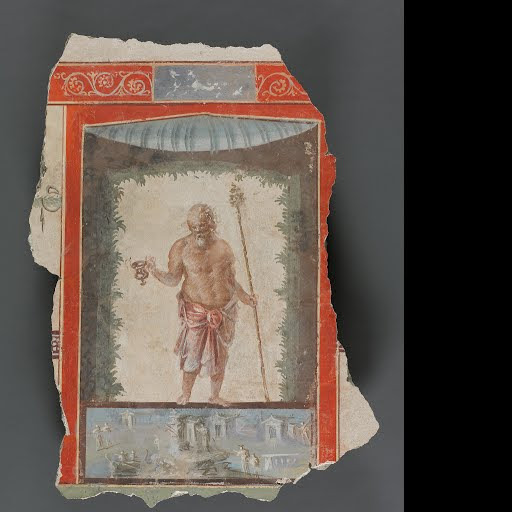
(Fresco fragment depicting an old Silenos with kantharos and thyrsos, AD 1-79, Unknown)
Similar attention to detail can be seen in this Roman wall painting of the old satyr Silenus. The painter’s skillful use of red shadows and pink highlights builds up the volume of his chest and stomach, which appear both soft and sturdy at the same time.
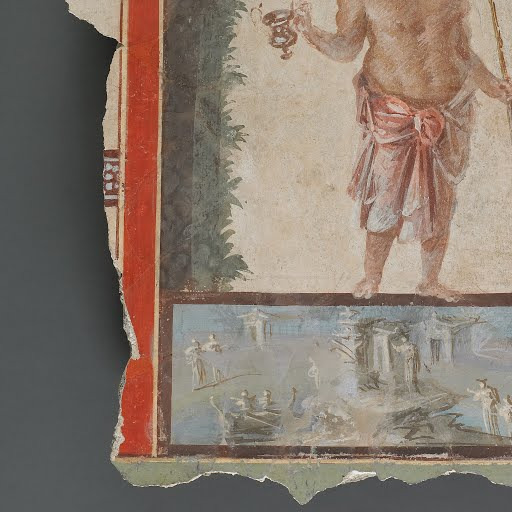
These fleshly older satyrs were symbols of pleasure-seeking and leisure.
Fragile Bodies on the Margins
Skinny or underweight bodies were also criticized, in part because of the association between emaciation and illness. Thinness could also negatively reflect on one's character.

(Miniature skeleton, unknown)
Ancient authors often noted a person's skinny frame as a way of pointing out their intellectual or social irrelevance.
The association of thinness and powerlessness is sometimes exploited in representations of enslaved individuals, domestic servants, and those otherwise marginalized in society.

(Finial with a resting youth, unknown)
On this figurine of a resting youth, the individually shaped ribs might suggest that the figure is undernourished.

In depictions of older individuals, such as this statuette of an old woman, underweight features are often used to indicate frailty.

(Statuette of an old woman, 100-001 BCE)
Such subjects were popular in the Hellenistic period (c. 330-31 BC) —a time of unprecedented social inequality — and consciously aestheticized:
"When we see emaciated people we are distressed, but we look upon statues and paintings of them with pleasure, because imitation, as such, is attractive to the mind's nature."
- Plutarch, Quaestiones convivales 5.1.
Size and Gender
Body fat was also linked to gender, especially in the Roman Empire. While bodies of women were routinely criticized by Roman authors, fluctuation in weight did not render them less feminine. By contrast, both fat and skinny men were explicitly mocked as effeminate, lacking either physical strength or stamina.
Biographies of unpopular Roman emperors often weaponize their body size in this way. Of the emperor Galba, the biographer Suetonius writes, "it is said that he was a heavy eater," immediately before turning to rumors about his inclinations towards "unnatural desires."
Such fat-shaming seems not to have mattered to the emperors themselves. Their official portraits show little concern for concealing the fullness of their faces.
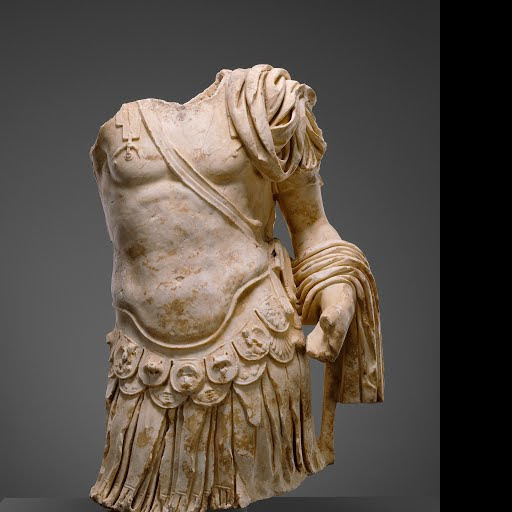
(Torso of a cuirassed statue, unknown)
The situation may have been different in military affairs. The anxieties Roman men felt about their bodies can be seen in their choice of armor. Their bronze breastplates were decorated with chiseled pectorals and washboard abs, creating the illusion of a skin-tight fit.
It is unlikely that such breastplates were meant to deceive, any more than the fat suits of comic actors. What they offered to their wearers was the illusion of inhabiting — for a moment — the ideal body of a Polykleitan statue.
Divine Softness
A closer look at ancient art reveals that the bodies of gods were sometimes less harshly judged than those of mortals.
Depictions of certain gods regularly focus on the softer parts of their bodies.
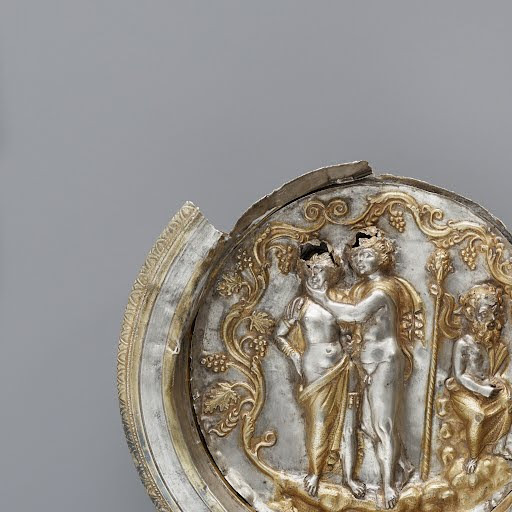
(Bowl with a medallion depicting Dionysos and Ariadne, unknown artist, -100)
The maker of this Hellenistic silver medallion went out of their way to show the curvy bodies of the wine god Dionysus and his wife Ariadne, engraving lines under their bellies to highlight the sensuality of their encounter.
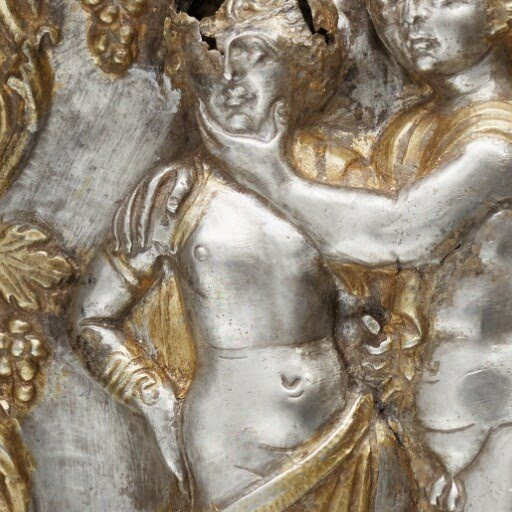
Some popular representations of the love goddess Venus, such as the so-called "Crouching Venus" type, unquestionably emphasize the fleshiness of her body.

Statue of a Crouching Venus Statue of a Crouching Venus, Unknown, A.D. 100–150, Provenant de la collection : The J. Paul Getty Museum
Modern observers have highlighted the positive associations between fleshiness and fertility expressed by a variety of Greek and Roman authors, but there is more to the story.
The rolls of flesh on the goddess's belly also gave the ancient sculptor a means of creating a very intimate encounter between viewer and goddess.
To ancient viewers of all ages and genders, accustomed to seeing gods represented solemn and upright, the crouching pose allowed a glimpse into the goddess's private world.
The crouching goddess seemed more approachable to worshippers, in part because her body moved in ways they could recognize from their own lived experience. The softness of Venus’s body made the cold, hard marble come to life.
#ancient greece#ancient rome#body positivity#fatphobia#greek gods#body fat#venus#dionysus#dionysos#ariadne#roman emperors#satyrs#underweight#satyr#silenus#ancient art#ancient greek art#body types#art#weight#ancient greek society#roman empire
26 notes
·
View notes
Text
Soap
I am about to get extremely nerdy and excited about ancient soaps. Consider yourselves warned, this is gonna be me getting giddy about tracking a plant through linguistic records, and botanical records.
All who don't want to geek out about this topic, I hope you enjoy your future scrolling and have a nice day. All who do, click the read more and join me down the rabbit hole.
So, soap.
There's an unfortunate belief that we in the modern period are the first descendents of the ape to understand the need of personal hygiene, sterilisation, and washing. This is wrong. We've understood dirt is bad for general health (as in food, water, and wounds) for thousands of years.
Allow me a few examples for the sceptical:
Galen, Hygiene Vol I, Book I. written between 165-175 CE.

And for those looking for something a wee bit older:
Unknown Author, writing style Sumerian dates to Third Dynasty of Ur, c.2158-2008 BCE. Page from Healing Hands by Guido Majno 1992


As Manjo points out in his discussion of this prescription, note the hot water as well as the beer.
I could go on, but I hope you see why I find 'all ancient peoples were dirty and only had a bath once a year,' an asinine statement. So, onto the 'Dark Ages'.
I needed to figure out what compound or substance the Lǽce, or medical practitioners in the story, would use to clean their hands after an examination. I've recently been looking into something of a plant 'shopping list' cross-referencing archaeological records and written records for what came to Northern Europe and when. Here's where I attempt to introduce you all to the term 'archaeophyte'.
An Archaeophyte is a plant that came to the geographical area or region of study before 1500 CE. Any plant that made its way to an area before this date, be with human intervention or without, falls into this category. A plant that arrives after this date is a Neophyte.
An example for the UK; Corn Marigold, Chrysanthemum segetum for all you folks who want to see me fight my way through Latin, arrived in the UK first in the Iron Age (in this context being about 940 BCE to 43 CE) as evidenced by archaeological finds, with later examples occurring in a Roman, then medieval context.
See Archaeolophytes in Britain, Preston, Pearman, and Hall for sources and more information
Right, so I've been constructing this list of plants I can use in the story. My rules are that it must occur in a Pre-Roman context North of Frankfurt, Germany, and West of Warsaw, Poland. The reasoning for this ruleset is too complicated to go into in this post, so just try and accept this as my baseline.
I started to go through this list this morning, looking for a plant that could be used for cleaning hands in a medical setting. I looked at Yarrow to begin with, it being an Archaeophyte for the area with archaeological evidence dating back to the Neolithic period (10,000-4,500BC) in the context of feasting at stone henge. It has limited scientific write up, but there is some evidence to suggest that it has antibacterial properties, anti-inflammatory properties, and may help with the staunching of wounds (see Medical Plants, Simmonds, Howes, and Irving 2016, Royal Botanical Gardens Kew, and Culpeper's Complete Herbal modern edition edited by Steven Foster, 2019).
So far so good, but not in anyway perfect. Then, while flicking through one of my books to locate yet another entry on yarrow to triple check my notes, I skimmed past an entry for a plant called Soapwort. To say I sat and stared at it dumbfounded for a while is an understatement.
My first thought was that the suffix 'wort' was a very good sign. 'Wort' comes from the Old English 'wyrt', which basically means a usable plant, be that edible as food, used in dyes, or applied in medicine. However, Old English speakers are infamous for making new compounds up of familiar elements to suit imported objects or ideas.
What I should have done next was to look up the etymology of the word 'soap', but I didn't. Instead, I went running back to the 'Archaeophytes in Britain...' article and did a ctrl F search for the Latin name, 'saponaria officinalis'. As soon as I typed it in, my heart sank.
Soap - Saponaria
That's a little too close for comfort, implying that the names were not only related, but likely came from the Old Latin, indicating that I was dealing with a re-emerging Roman export. Briefly, the Anglo-Saxons, the speakers of the Old English Language, came to the UK sometime in the 400s CE, after Rome withdrew. There is a marked dip in Roman culture, architecture, goods and especially language in this time, indicating some think, that the Roman settlers were not widely integrated with the Brittonic peoples. Latinised, or Late Roman, culture and influences do not really re-enter the UK until the Christianisation of the Anglo-Saxons some time later. When it did re-emerge, the Latin was favoured in academic contexts over the Old English, and for this reason I choose to use the Old English as a good waypoint for pre-existing features.
Back to the article on Archaeophytes. There is no known record of soapwort in the UK before the 1500's CE. However, it is found in Germany and Poland as a 'native' species, meaning that it predates 1500 CE, and reached the geographic area without human intervention (this can be discerned through where a sample is found, for example bog or wetland pollen deposits, or ancient forest remains). This slots it nicely into my 'can use' category.
It was only at this point that I decided to look up the etymology of 'soap'.
Soap <- Sope Middle English <- Sápe Old English <;- Saipá Proto-Germanic <- seyb- Proto-Indo-European
Which rather made all the fussing I did about Roman and Latin mute. -_-
The Anglo-Saxon's called Soapwort either leáþorwyrt or grundsópa by the by, meaning literally lather wort and ground soap.
The plant Soapwort contains large amounts of Saponin (about 20% when flowering, according to Wikipedia). This produces a lather when in contact with water, and basically breaks down various cell membrane components. That's about as far as my limited grasp of biochemistry leaves me high and dry, I'm afraid, but hopefully you get the idea.
In short summary; the Lǽce in the story can literally use soap, and I should always look up etymologies before I go traipsing through academic papers. Hope those who made it this far found it interesting!

Photo Credits to TeunSpaans Wikipedia
59 notes
·
View notes
Text

New Year’s Holiday Ikonahime-no-Mikoto Shrine Before Sunrise
Location: Shirahama, Shimoda, Shizuoka, Japan
Timestamp: 05:32 on January 3, 2024
Pentax K-1 II + DFA 28-105mm F3.5-5.6
34 mm ISO 100 for 2 sec. at ƒ/11
Ikonahime-no-Mikoto Shrine (伊古奈比咩命神社), colloquially called Shirahama Shrine (白浜神社), is located next to the beautiful Shirahama Beach on the eastern coast of the Izu Peninsula. It is about 175 km (107 mi) southwest of Tokyo. I reached the beach in less than three hours by driving through the night, avoiding heavy traffic and ensuring access to an empty parking space.
Historical records make reference to this shrine as far back as 392 BCE, making it 2,415 years old. This shrine complex is the oldest one on the Izu Peninsula.
In this shot, we can see the main worship hall, which was rebuilt in 1860. The main sanctuary that houses the shintai (an object believed to contain the spirit of a deity) is up at the top of the hill behind the main hall.
Visitors to can pray for the following at this shrine:
・Warding off evil spirits
・Successful marriage
・Maritime safety
・Good luck in making large fish catches
・Prosperous business endeavors
・Safe delivery of a newborn
・Traffic safety
・Family safety
As the shrine welcomes visitors for the New Year's holidays, a special purification ritual called chinowa-kuguri (茅の輪くぐり) takes place. Participants step through a big hoop of grass three times in a figure 8 fashion, cleansing themselves of any impurities and praying for sound health.
Check out my ad-free blog post, where I include Google Maps links to the shrine, along with additional information about the history of this location. You can find the post at https://www.pix4japan.com/blog/20240103-shirahama
#伊豆半島#風景写真#茅の輪くぐり#白浜神社#pix4japan#pentax_dfa28105#pentaxk1mkii#travel photography#Japan#Izu#Shimoda#Shirahama Shrine
10 notes
·
View notes
Text
trial of Publius Cornelius Scipio Aemilianus
date: early 140 BCE
charge: iudicium populi [trial before the people] (for irregularities in performing lustrum as cens. 142)
defendant: P. Cornelius Scipio Aemilianus cos. 147, 134, cens. 142, spoke pro se [for himself] (ORF 21.V)
prosecutor: Ti. Claudius Asellus tr. pl. 140
other: Scipio delivered at least five orations against Claudius Asellus.
Cic. de Orat. 2.258?; 2.268; Gel. 2.20.6; 3.4.1; 4.17.1 = Lucil. 394M, 6.11.9; Fest. 360.29-32L?
Fraccaro (1912) 376-82; Scullard (1960) 69; Astin (1967) 127, 175-77, 256
See Astin (1967) 256 #22 on whether the interchange between Scipio and Asellus recorded in de Orat. 2.258 should be attributed to this trial, or to a recognitio equitum [review of the equites], in which Scipio as censor attempted to have Asellus deprived of his horse.
49 notes
·
View notes
Photo

Border Fragment. 450–175 BCE. Credit line: Bequest of Arthur M. Bullowa, 1993 https://www.metmuseum.org/art/collection/search/316945
#aesthetic#art#abstract art#art museum#art history#The Metropolitan Museum of Art#museum#museum photography#museum aesthetic#dark academia
23 notes
·
View notes
Text
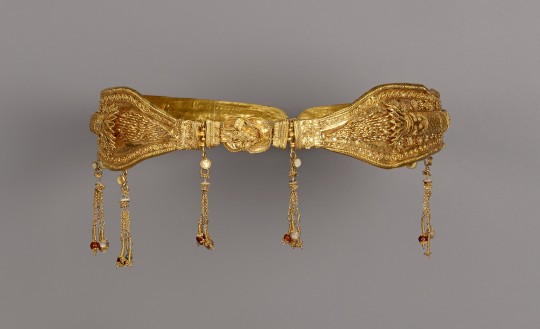
Diadem, Ptolemaic, 225-175 BCE
Gold, glass paste, bone or pearl, garnet, cornelian, and moonstone
From the Getty Villa Museum
#diadem#gold#fashion#fashion history#accessory#history#225 bce#200s bce#175 bce#100s bce#bce#ancient#ptolemaic#ancient greek#ancient egyptian#greek#egyptian#ancient greece#ancient egypt
427 notes
·
View notes
Photo
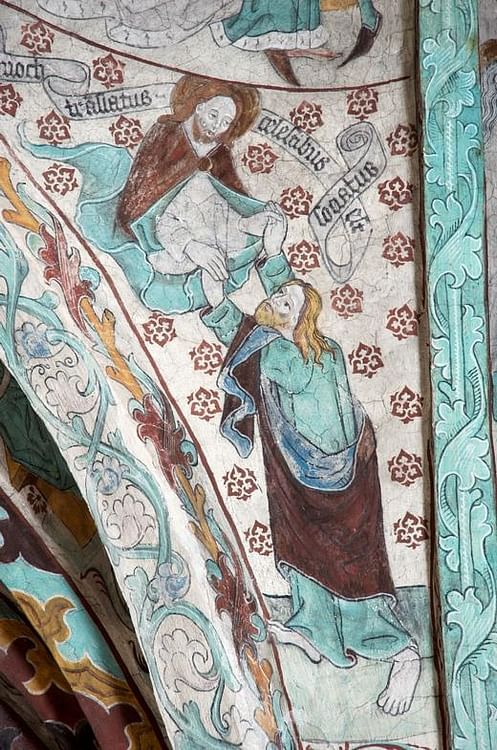
Enoch
In the book of Genesis in the pre-flood period, Enoch was the son of Jared and the father of Methuselah. There are few details about Enoch. We learn that he lived 365 years, and then Enoch "walked faithfully with God; then he was no more, because God took him away" (Genesis 5:24). This cryptic note was interpreted to understand that Enoch did not die a physical death but was taken by God for continued existence in heaven.
Within the traditional texts, he is not referred to again, but he became a major figure during the Second Temple Period (450 BCE - 70 CE). If you have read the gospels, both the concept and the reference to Jesus of Nazareth as the "son of man" is drawn from the books of Enoch.
The Books of the Prophets
Israel suffered several major disasters throughout its history. In 722 BCE, Assyria conquered the Northern Kingdom of Israel. The conquerors switched populations, moving their own people into the region and this is when ten of the twelve tribes of Israel were lost to history. In 587 BCE, the Neo-Babylonian Empire conquered the Southern Kingdom of Judah, destroying Jerusalem and the Temple complex. The books of the Prophets blamed these disasters on the sins of the people, particularly the sin of idolatry.
At the same time, the Prophets offered a message of hope., that the God of Israel would intervene in human history one final time, raising up a messiah figure ("anointed one") to lead the armies of Israel against the nations. At that time, Israel would be restored to its former glory and God’s original plan for humans (the Garden of Eden) would be established on earth. The shorthand phrase for this conviction was "the kingdom of God on earth."
In 330 BCE, Alexander the Great (r. 336-323 BCE) conquered the regions of the Mediterranean Basin. Upon his death, his generals divided his empire during the Wars of the Diadochi. In 167 BCE, the Syrian king Antiochus Epiphanes IV (175-164 BCE) ordered the extinction of Jewish customs (their religion). The Jews, under the leadership of a family known as the Maccabees, rose against them and eventually drove them out in the Maccabean Revolt.
Not all Jews agreed with the ruling house of the Maccabees (the Hasmoneans) and so we have the formation of various groups or sects of Jews: the Pharisees, Sadducees, Essenes, and Zealots. By 63 BCE, Rome had conquered Israel, and many of these groups felt the urgency that God should intervene now. There was a renewed interest in the details of the prophetic books, updated to reflect the current situation. Additional texts were written, recalling ancient figures of Israel to interpret views on the final days.
By the Second Temple period, there were no more traditional Prophets of Israel. Instead, we have the development of seers, men who experienced out-of-body journeys to heaven. While there, they were shown secrets of the future intervention by God. 'Apocalypse' is the term for a disclosure, the revealing of hidden things. As the revelations concerned the final days (eschaton in Greek), scholars apply the term 'apocalyptic eschatology' to the literature of this period. To convey credibility, the texts were always written in the name of an individual who was known to be in heaven. The figure of Enoch became popular as the source of the revelations.
Continue reading...
24 notes
·
View notes
Text
OLD CROGHAN MAN
OLD CROGHAN MAN
Bog body discovered in Ireland in 2003
The Old Croghan Man is a preserved torso and arms of an Irish Iron Age body which was found in June 2003. The remains were found in Croghan Hill, north of Daingean, County Offaly.
In his own life time he would have been 1.96 metres tall; his nails were well-kept and was in good health at the time of his death. He lived around 362-175 BCE. He was killed by a knife in the chest. A cut on his upper arm shows he faced his killer and tried to deflect the strike. After death, he was decapitated and his body was sawn in half.
Today the body is on display at the National Museum of Ireland in Dublin.

#oldcroghanman #bogbodys #ireland #croghanhill #history
3 notes
·
View notes
Text

After we light the candles on Hanukkah there is a tradition that women refrain from work while the candles are burning. Why are women given this special honor? Because of Judith, the Jewish woman who singlehandedly saved her entire town during a brutal siege.
At the time of the Maccabee revolt, around 175 BCE, the Greek Empire ruled Judea. The Jewish town of Bethulia was under siege by Holofernes, a brutal general. He demanded that the Jews stop practicing their religion and instead adopt Hellenistic values and culture.
The Jews refused to bow to the Greek gods. Holofernes tried to starve them into surrender, cutting off the food and water supply to Bethulia. The townspeople grew desperate. They begged their leaders to surrender. Uzzia, the commander of defense forces, refused, but finally agreed to wait five more days, and if no salvation came, he would surrender.
At this point Judith (Yehudit), daughter of the high priest, stepped forward in outrage. “Why do you test G-d, giving Him only five days in which to send us His help? If you truly have faith in G-d, you must never give up your trust in Him. Don’t you know that surrender to Holofernes is worse than death??”
Judith came up with a plan. A beautiful young widow, she dressed in her nicest clothes and traveled to the enemy camp, praying as she went. She carried a basket with wine and salty cheese. Judith told the sentries at the gate that she had information for Holofernes regarding how to finally take the city of Bethulia. Dazzled by her feminine charm, they let her in to see the general.
Judith went into Holofernes' chamber. The general was pleased to see such a lovely young woman, and accepted her wine and cheese. The cheese was so salty that it made him drink a great deal of wine, and soon he fell asleep. Then Judith unsheathed Holofernes’ sword, and chopped off his head.
Humiliated at their defeat by a woman, the Greek forces retreated from Bethulia, allowing the Jews to live freely and practice their religion.
For her stunning courage in slaying the enemy of her people, we honor Judith as our Thursday Hero, Hanukkah edition.
Accidental Talmudist
106 notes
·
View notes
Text
38. Great Altar of Zeus and Athena at Pergamon

Found in Asia Minor (present-day Turkey)
Hellenistic Greek
Created c. 175 BCE
Marble (architecture and sculpture)
4 notes
·
View notes
Text
image id for this post
CptAllenHistory
No, Jews were not all exiled from Israel for 2,000 years only to return & establish a modern state. Based solely on archeological evidence, it is established fact that Jews have had a continuous presence in the Land for at least 3,200 years. Here is just some of that proof.
Archeological Proof of at Least 3,200+ Years of Continuous Jewish History in Israel
1208 BCE: Merneptah Stele: earliest archeological evidence of Jews in Israel
1050-970 BCE: Khirbet Qeiyafa Ostracon: written in Hebrew and discovered just west of Jerusalem
926 BCE: Karnak Temple: Pharaoh Shoshenq I listed conquests in Israel and Judah
801-900 BCE: Tel Dan Stele: earliest reference to David, King of Israel
733 BCE: Nimrud Tablet K.3751: references the land of Judah
597 BCE: Ostracon #18: earliest reference to the First Temple, found just south of Jerusalem
539-538 BCE: Cyrus Cylinder: marking return of Jews to Land of Israel after less than 50 years in Babylonian exile
350 BCE: Yehud Coins: currency from Persian-era Judah
187-175 BCE: Heliodorus Stele: documents appointment of administrator over the Temple in Jerusalem
4 CE: Trumpeting Place Inscription: discovered at the southern wall of the Temple Mount where "trumpeting" would declare the Sabbath
71: Judea Capta Coin: Roman coin minted to commemorate victory over Judea
81: Arch of Titus: Roman monument to sack of Jerusalem & pillage of the Jewish Temple
132-136: Freedom in Israel Coin: minted during Bar Kokhba Revolt's brief return of Jewish sovereignty in Judea
200-400: Beit She'arim Necropolis: Jewish burial site in the town of Kiryat Tiv'on
301-500: Huqoq Synagogue: mosaic floor of a Jewish synagogue
401-500: Beit Alfa Synagogue: three-paneled mosaic floor of Jewish synagogue
401-700: Menorah Medallion: golden torah breast plate discovered near the Temple Mount from a brief period of Jewish autonomous rule
401-900: Susiya Synagogue: Mosaic from synagogue in Southern Judean Hills
801-1000: Nuba Mosque: inscription calls Dome of the Rock Bayt al Maqdis - derived from Hebrew Beit Hamikdash meaning "The Holy Temple"
1166: Maimonides' Reflections: writing about praying at the Temple Mount
1267: Ramban Synagogue: oldest intact Jewish synagogue in Jerusalem
1490s: Abuhav Synagogue: built after Jewish expulsion from Spain
1570s: Ashkenazi Ari Aynagoguei: built in Tzfat in honor of Rabbi Isaac Luria
Early 1600s: Yochanan ben Zakai Synagogue: Jerusalem synagogue
1764: Istanbuli Synagogue: Jerusalem synagogue
1873: Peki'in Synagogue: synagogue in Northern Israel
1872-1948: Tiferet Yisrael Synagogue: Jerusalem synagogue blown up by the Jordanian Legion during Israel's War of Independence in 1948
1 note
·
View note